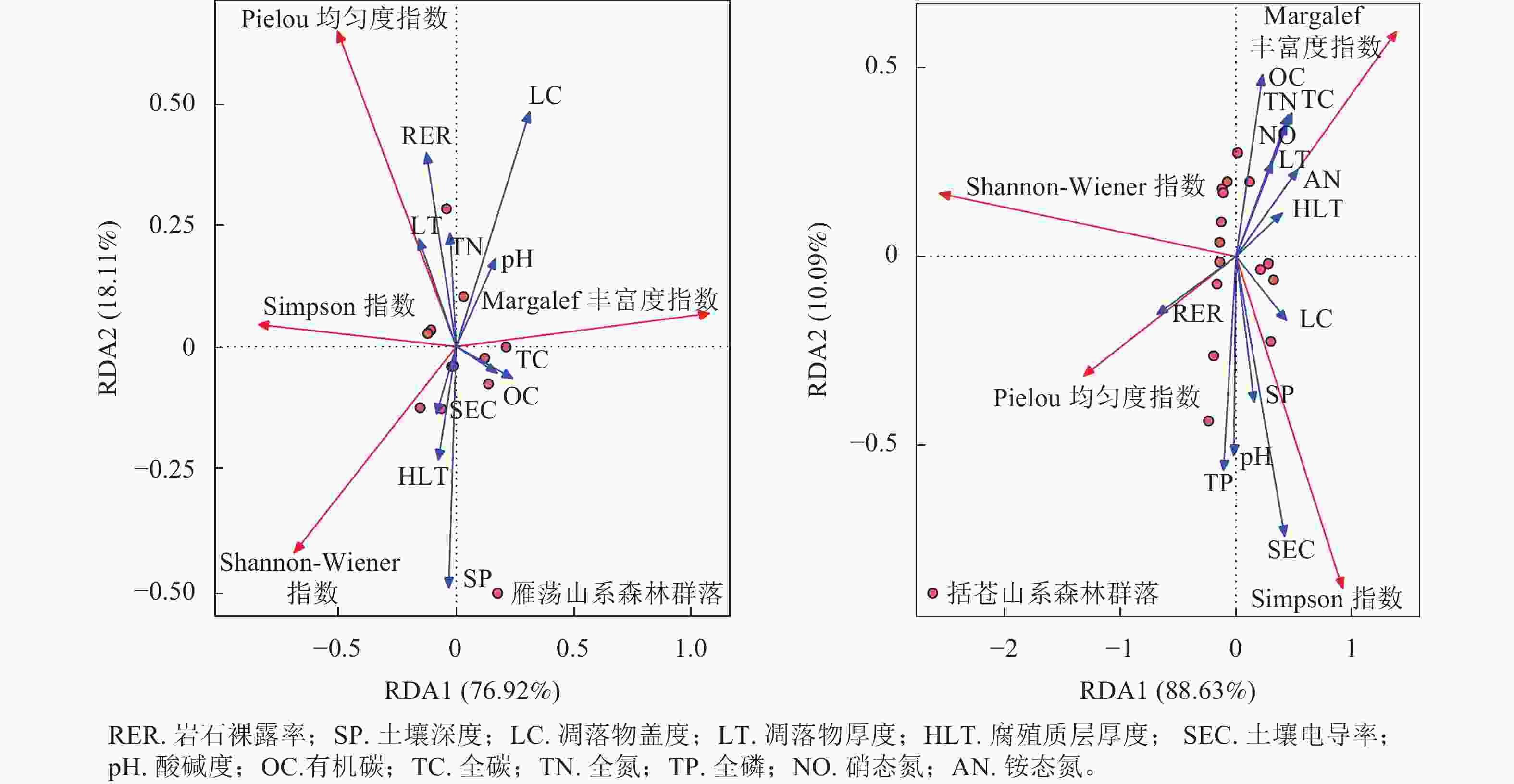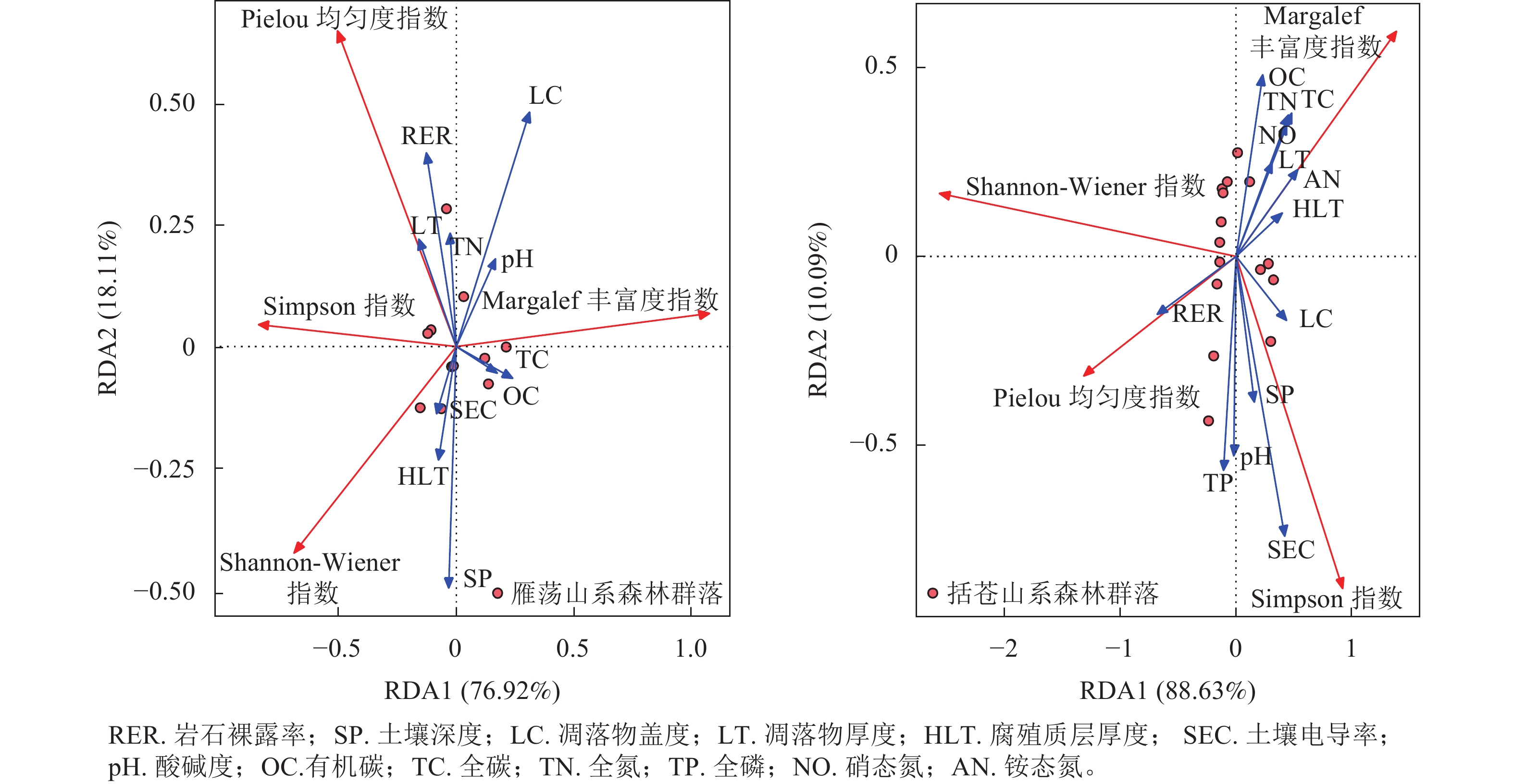-
森林群落是植物在自然条件下分布的最重要的群落类型[1]。其中亚热带常绿阔叶林是全球亚热带大陆东岸湿润气候和季风气候区的典型植被[2],中国是亚热带常绿阔叶林分布面积最大的国家[3]。亚热带常绿阔叶林具有极高的物种多样性、丰富的生物资源和巨大的环境效益[4],对保护环境、维持全球性碳循环平衡和人类可持续发展等具有重要作用[5]。
群落结构是认识群落组成、变化及发展趋势的基础,能够反映群落对环境的适应、群落的动态和机能,并且会影响生态系统的功能特征[6]。群落的垂直结构和径级结构是群落结构中重要的形态和结构特征[7],其中径级结构指林分内各种直径林木按径阶的分配状态。李其斌等[8]认为径级结构是影响植物多样性分布的主要因子;BOULANGEAT等[9]发现乔木物种多样性指数与其周围树种径级存在直接的联系;刘菊莲等[10]认为径级结构不仅揭示了种群在特定时间内个体在不同生长或发育阶段的分布情况,还反映了种群的发展趋势和潜在变化。因此,研究群落径级结构及其更新机制,对阐明种群生态特性、更新对策乃至群落的形成及其稳定性与演替规律等具有重要意义[11]。
物种多样性一直是生态学研究领域的重要内容,森林植被物种多样性与环境因子相关性研究受到了广泛关注。研究发现:人为干扰[12]、林分密度[13]等生物因子,海拔[14]、地形[15]、气候[16]等非生物因子均会对物种多样性产生影响。而土壤环境因子可以通过调节植物营养资源的供给影响森林群落,一定程度上使得土壤环境因子与物种多样性之间的关系更为复杂[17−18]。朱夏夏等[19]在辽东山地老秃顶子发现土壤电导率和pH与Shannon-Wiener指数呈正相关;张荣等[20]在蒙顶山发现全氮与Shannon-Wiener指数呈正相关;南国卫等[21]在黄土高原地区发现有机碳与Shannon-Wiener指数和Pielou均匀度指数呈负相关。因此土壤相关因子对森林群落多样性影响的研究有助于理解物种多样性和土壤之间相互耦合的过程及作用机制。
台州地区位于浙江东南沿海区域,受海洋性季风气候影响显著,南部雁荡山系和北部括苍山系的亚热带常绿阔叶林是该区域的主要森林植被类型。本研究选择2类山系的亚热带常绿阔叶林为研究对象,对比其群落结构和物种组成的差异及其与土壤环境因子的关系,对进一步认识台州沿海地区亚热带常绿阔叶林特征及其变化具有重要意义。
-
雁荡山系(28°12′~28°32′N,121°09′~121°44′E,海拔为42.36~220.55 m)和括苍山系(28°27′~28°41′N,120°47′~121°20′E,海拔为15.63~663.63 m)地处亚热带季风气候区,冬夏季风交替明显,四季分明,温暖湿润,雨量充沛,光照充足,无霜期长。年均气温为17.3 ℃,最冷月(1月)平均气温为6.7 ℃,最热月(7月)平均气温为28.1 ℃。全年有2个明显的降水期,分别为3—6月和8—9月,年均降水量为
1649.6 mm。地带性植被为亚热带常绿阔叶林。 -
2023年9—11月在雁荡山系和括苍山系的典型亚热带常绿阔叶林分别设置11和15个20 m×20 m样方(表1),将每个样方都划分为16个5 m×5 m的小样方。依据文献[22−23]的研究方法,标定样方中所有胸径(DBH)≥1 cm的乔木个体,并划分为3个等级[24−25],1 cm≤DBH<5 cm为小径级,5 cm≤DBH<20 cm为中等径级,DBH≥20 cm为较大径级。记录每株乔木名称、胸径和高度,同时记录每个样地的土壤生态因子(岩石裸露率、土壤深度、凋落物盖度、凋落物厚度、腐殖质层厚度和土壤电导率)。在每个20 m×20 m样方随机选取5个监测点,用环刀取土,根据LY/T 1215—1999《森林土壤水分-物理性质的测定》方法测定土壤养分相关指标(pH、有机碳、全碳、全氮、全磷、硝态氮、铵态氮)。
样地 森林群落 雁荡山系
1~111. 马尾松Pinus massoniana+檵木Loropetalum chinense;2. 樟树Cinnamomum camphora+枫香Liquidambar formosana;3. 窄基红褐柃Eurya rubiginosa;4. 樟树;5. 樟树;6. 木荷Schima superba;7. 枫香;8. 檵木+隔药柃Eurya muricata ;9. 木荷;10. 青冈栎Quercus glauca+枫香;11. 青冈栎 括苍山系
12~2612. 樟树;13. 檵木;14. 木荷;15. 木荷;16. 枫香;17. 木荷+苦槠 Castanopsis sclerophylla;18. 隔药柃;19. 乌桕Triadica sebifera;20. 榔榆Ulmus parvifolia ;21. 苦槠+枫香;22. 杉木Cunninghamia lanceolata+枫香;23. 杉木;24. 木荷;25. 木荷;26. 木荷+薄叶山矾 Symplocos anomala Table 1. General situation of plots in forest communities of Yandang and Kuocang Mountains
-
重要值是反映各物种在森林植被中作用的指标,以数量、胸径和高度等3个指标分析。分别统计并比较雁荡山系和括苍山系森林群落各物种重要值的变化。采用Simpson指数、Shannon-Wiener指数、Pielou均匀度指数和Margalef丰富度指数反映2类山系森林群落物种多样性水平。物种重要值和群落多样性指数采用任学敏等[26]和FEEST等[27]的方法进行计算。
采用SPSS 27.0进行独立样本t检验,分析雁荡山系和括苍山系森林群落多样性指数差异。采用R 4.3进行冗余分析(RDA)检验环境因子与物种多样性的相关性。采用SigmaPlot 14.0作图。
-
雁荡山系森林群落共记录乔木67种,隶属31科46属。科分析结果显示:山矾科Symplocaceae的物种最多,有7属7种,蔷薇科Rosaceae和壳斗科Fagaceae次之,分别有3属6种和4属6种。属分析结果显示:山矾属Symplocos的物种最多,有7种,其次为石楠属Photinia,有4种。括苍山系森林群落共记录乔木89种,隶属38科62属。科分析结果显示:杜鹃花科Ericaceae的物种最多,有5属9种,樟科Lauraceae次之,有5属7种。属分析结果显示:山矾属Symplocos的物种最多,有5种,其次为冬青属Ilex、榕属Ficus、山茶属Camellia和越橘属Vaccinium,各有4种。2类山系森林群落中重要值≥1%的共有物种为木荷Schima superba 、枫香Liquidambar formosana 、樟树Cinnamomum camphora、杉木Cunninghamia lanceolata、檵木Loropetalum chinense 、窄基红褐柃Eurya rubiginosa 、青冈栎Quercus glauca、苦槠Castanopsis sclerophylla、水团花Adina pilulifera 、隔药柃Eurya muricata和白花龙Styrax faberi (表2)。括苍山系森林群落中木荷重要值为27.37%,比雁荡山系高16.80%,苦槠和隔药柃的重要值在括苍山系森林群落也明显高于雁荡山系。但括苍山系森林群落中枫香、樟树、檵木和青冈栎的重要值均低于雁荡山系,杉木、窄基红褐柃、水团花和白花龙的重要值在2类山系森林群落中变化不明显。
样地 物种 个体数/株 平均高度/m 胸高断面积/(m2·hm−2) 重要值/% 雁荡山系1~11 枫香Liquidambar formosana* 80 9.22 2.0656 13.11 木荷 Schima superba* 90 8.18 1.2252 10.53 樟树Cinnamomum camphora* 25 10.95 1.9007 8.95 杉木Cunninghamia lanceolata* 107 5.18 0.6754 8.10 马尾松 Pinus massoniana 62 6.13 1.0626 7.05 檵木 Loropetalum chinense* 134 3.51 0.1017 6.40 窄基红褐柃Eurya rubiginosa* 97 3.87 0.1205 4.99 青冈栎Quercus glauca* 26 10.68 0.7822 4.84 苦槠 Castanopsis sclerophylla* 26 7.53 0.2777 2.64 水团花 Adina pilulifera* 50 3.46 0.0601 2.46 栲树Castanopsis fargesii 31 5.91 0.1308 2.24 羊舌树Symplocos glauca 41 3.41 0.0448 1.99 赤楠Syzygium buxifolium 45 2.79 0.0177 1.93 隔药柃Eurya muricata* 44 2.56 0.0163 1.83 毛八角枫 Alangium kurzii 17 5.9 0.1807 1.60 白花龙 Styrax faberi* 26 4.08 0.0335 1.37 野桐 Mallotus tenuifolius 27 3.50 0.0259 1.31 山茶 Camellia japonica 17 5.57 0.0747 1.21 中华杜英 Elaeocarpus chinensis 16 5.92 0.0594 1.13 括苍山系12~26 木荷 Schima superba* 475 10.12 5.3722 27.37 薄叶山矾 Symplocos anomala 320 4.71 0.2163 7.43 杉木Cunninghamia lanceolata* 104 7.93 1.4826 6.18 枫香 Liquidambar formosana* 68 9.88 1.6550 5.82 窄基红褐柃Eurya rubiginosa* 253 3.15 0.0674 4.79 苦槠 Castanopsis sclerophylla* 106 6.68 0.8548 4.61 隔药柃Eurya muricata* 116 3.88 0.4328 3.28 马银花Rhododendron ovatum 140 4.48 0.0695 3.06 樟树Cinnamomum camphora* 22 11.45 1.0489 2.86 青冈栎Cyclobalanopsis glauca* 62 8.38 0.4343 2.77 水团花 Adina pilulifera* 108 3.86 0.1640 2.53 树参 Dendropanax dentiger 67 6.62 0.2697 2.31 檵木Loropetalum chinense* 89 4.89 0.1484 2.23 麂角杜鹃 Rhododendron latoucheae 92 4.33 0.0979 2.15 鼠刺 Itea chinensis 88 4.23 0.1171 2.07 白花龙 Styrax faberi* 61 4.00 0.0564 1.37 红楠Machilus thunbergii 40 4.21 0.1512 1.16 檫木 Sassafras tzumu 17 8.54 0.2380 1.02 说明:*表示该物种为2类山系森林群落共有物种。 Table 2. Dominant species with importance value ≥1% in forest communities of Yandang and Kuocang Mountains
2类山系森林群落多样性(表3)分析显示:雁荡山系和括苍山系森林群落的Simpson指数和Margalef丰富度指数差异不显著,而雁荡山系森林群落Shannon-Wiener指数和Pielou均匀度指数显著高于括苍山系森林群落(P<0.05)。
研究样地 Simpson指数 Shannon-Wiener指数 Pielou均匀度指数 Margalef丰富度指数 雁荡山系森林群落 0.80±0.15 2.19±0.55 0.48±0.11 3.84±1.18 括苍山系森林群落 0.81±0.10 1.60±0.81 0.34±0.17 3.64±1.05 t −0.28 2.24 2.54 0.44 P 0.78 0.04* 0.02* 0.66 说明:数据为平均值±标准差;*表示差异显著(P<0.05)。 Table 3. Diversity of forest communities in Yandang and Kuocang Mountains
-
径级结构(图1)分析显示:2类山系森林群落乔木(DBH≥1 cm)总个体径级结构呈倒“J”型分布。在雁荡山系森林群落中,小径级个体有665株,占总个体数的53.7%;中等径级个体有396株,占总个体数的32.0%;较大径级个体仅有76株,占总个体数的6.1%。在括苍山系森林群落中,小径级个体有
1786 株,占总个体数的65.5%;中等径级个体有833株,占总个体数的30.5%;较大径级个体仅有109株,占总个体数的4.0%。
Figure 1. Diameter distribution of trees (DBH≥1cm) of forest communities in Yandang and Kuocang Mountains
2类山系森林群落重要值≥1%的共有物种为11种(图2)。樟树、檵木和青冈栎在2类森林群落的径级结构差异明显,雁荡山系森林群落的樟树和檵木各径级个体数明显高于括苍山系,括苍山系森林群落的青冈栎个体数大部分属于小径级范围;木荷和隔药柃径级结构呈偏正态分布,木荷个体集中分布在1 cm≤DBH≤10 cm内,2类山系森林群落中隔药柃大径级较少,而且雁荡山系个体数集中在DBH<4 cm内。枫香的径级结构呈平均分布,苦槠、杉木、窄基红褐柃、水团花和白花龙的径级结构呈倒“J”型。
-
雁荡山系和括苍山系森林群落植物多样性与环境因子的冗余分析(图3)结果显示:雁荡山系森林群落排序轴Ⅰ解释了总变量的76.92%,与有机碳和全碳相关;排序轴Ⅱ解释了总变量的18.11%,与土壤深度、凋落物厚度、土壤电导率、全氮和岩石裸露率相关。括苍山系森林群落排序轴Ⅰ解释了总变量的88.63%,与岩石裸露率和腐殖质层厚度相关;排序轴Ⅱ解释了总变量的10.09%,与土壤全磷、pH、土壤深度、土壤电导率和有机碳相关。冗余分析显示:2类山系森林群落Shannon-Wiener指数均与全氮呈负相关。岩石裸露率与雁荡山系森林群落Shannon-Wiener指数呈负相关,与括苍山系森林群落Shannon-Wiener指数呈正相关。土壤电导率与雁荡山系森林群落Shannon-Wiener指数呈正相关,与括苍山系森林群落Shannon-Wiener指数呈负相关。2类山系森林群落Pielou 均匀度指数均与岩石裸露率和pH呈正相关,均与全碳呈负相关。土壤电导率与雁荡山系森林群落Pielou 均匀度指数呈负相关,与括苍山系森林群落Pielou 均匀度指数呈正相关。全氮与雁荡山系森林群落Pielou 均匀度指数呈正相关,与括苍山系森林群落Pielou 均匀度指数呈负相关。2类山系森林群落Simpson指数与土壤电导率和岩石裸露率呈正相关,而与全碳呈负相关。2类山系森林群落Margalef丰富度指数均与全氮和全碳呈正相关,与土壤电导率呈负相关。
-
物种组成是决定群落性质的重要因素,也是了解生态系统维持机制的重要途径[28−29] 。通过研究雁荡山系和括苍山系森林群落的物种组成,发现括苍山系森林群落物种数多于雁荡山系。2类山系森林群落均以山矾科和杜鹃花科物种为主,这与以壳斗科物种为主的古田山常绿阔叶林[30]和以杜鹃花科物种为主的九龙山常绿阔叶林[11]具有一定相似性。2类山系森林群落重要值≥1%的共有物种有11种,如木荷、枫香、樟树等,这些物种在紫金山[31]、午潮山[1]等亚热带常绿阔叶林群落同样为优势物种,表明该地区亚热带常绿阔叶林中木荷、枫香、樟树等为普遍存在的优势种。括苍山系森林群落木荷的重要值高于雁荡山系,木荷是2类山系森林群落重要的优势物种,表明木荷在括苍山系森林群落构建中起到更重要的作用。这可能是2类山系森林群落在海拔上的差异,导致了水热条件的变化,进而造成了凋落物厚度、有机碳和全氮的差异。括苍山系森林群落的凋落物厚度较高,土壤养分含量高,这可能是木荷更具优势的原因。枫香和樟树在2类森林群落重要值较高,表明两者对2类山系森林群落生境都具有较高的适合度,但是雁荡山系森林群落枫香重要值高于括苍山系,樟树则反之,表明枫香更适合低海拔地区,而樟树更适合高海拔地区。雁荡山系森林群落Shannon-Wiener指数与Pielou均匀度指数均高于括苍山系。雁荡山系森林群落物种间数量分布相对均匀,优势物种优势度低,而括苍山系森林群落木荷生长茂盛,郁闭度大,林地凋落物较多,竞争胁迫导致其他物种数较少,因此括苍山系森林群落Shannon-Wiener指数与Pielou均匀度指数较低。表明括苍山系森林群落木荷优势明显,导致其多样性明显低于雁荡山系。
-
雁荡山系和括苍山系森林群落总个体径级结构均呈倒“J”型分布,江西大岗山低海拔常绿阔叶林[32]、鼎湖山南亚热带常绿阔叶林[33]等的研究也有类似的结果。群落个体集中在小径级(1 cm≤DBH≤5 cm),表明幼树储备丰富,自然更新良好,整体呈现稳定生长状态。雁荡山系森林群落的樟树和檵木各径级的个体数均高于括苍山系,表明樟树和檵木更适合生长在低海拔的雁荡山系森林群落。与雁荡山系相比,青冈栎在括苍山系森林群落小径级个体较多,可能由于括苍山系森林群落郁闭度较高,林下光照弱,而青冈栎为阳性树种,幼苗更新生长受到抑制,大径级的植株较少。2类山系森林群落多数物种个体径级结构呈倒“J”型分布,表明这些物种在2类山系森林群落均有良好的更新能力,这与天童山常绿阔叶林[34]的云山青冈Cyclobalanopsis nubium、栲树等优势物种的径级结构相似,表明主要优势物种更新能力强是亚热带常绿阔叶林的特点。木荷的径级分布呈偏正态分布,以中小径级个体为主,充足的幼苗是其种群稳定生长,处于优势地位的原因。由于亚热带常绿阔叶林区域水热光照条件好,木荷等林冠层高大的乔木可以合理利用光照水分,中龄期的个体处于快速生长期,竞争力强,因此个体数较多。而木荷等主要乔木均是阳性树种,冠幅较大造成郁闭度增大,林冠层对光资源截留导致林下的幼苗不易接受充足的阳光和水分,且还要与林下耐阴草本等共同竞争水分、土壤及营养物质,从而影响存活率,致使幼龄期个体数少,使林冠层径级呈偏正态分布[35]。
-
环境因子对植物群落的物种组成、结构和多样性等具有重要影响[36−37]。冗余分析结果显示:全氮增加对2类山系森林群落Shannon-Wiener指数具有抑制作用。SUDING等[38]发现:在氮限制的地区增加氮素会缓解种间竞争,使群落的物种多样性增加。而在氮素水平高的区域,氮素增加可能会加剧种间竞争,导致物种多样性的减少[39]。全氮增加降低了括苍山森林群落的Pielou 均匀度指数,但是增加了雁荡山系森林群落的Pielou均匀度指数,这可能与雁荡山系的植株密度较少有关,整体种间竞争水平较低,全氮的增加促进了多数物种植株的生长,从而提高了Pielou均匀度指数。岩石裸露率与括苍山系森林群落Shannon-Wiener指数和Pielou均匀度指数均呈正相关,这可能与光照有关,括苍山系的裸露岩石区域并没有高大乔木生长,容易形成林窗,导致岩石裸露区域物种和植株数均有显著增加。但是在雁荡山系森林群落,岩石裸露率则与Shannon-Wiener指数呈负相关。雁荡山系森林群落植株密度较少,岩石裸露率高的群落植株密度可能更为稀少,导致多样性指数下降。土壤pH决定了植株生存的适宜度[40−41]。土壤pH与2类山系森林群落Pielou 均匀度指数呈正相关。2类森林群落的土壤pH均值为5.6,土壤性质偏酸性,过低的pH会影响土壤微生物活动,进而影响植物多样性, pH的增加对物种生长起到促进作用,进而增加物种多样性。李其斌等[8]发现长白山土壤 pH与 Pielou 均匀度指数显著负相关,这与该区域土壤pH较高有关,pH增加反而抑制了物种多样性。土壤全碳含量越高,Pielou 均匀度指数越低,这与云顶山有机质与Pielou 均匀度指数呈负相关的结果一致[42]。土壤电导率对2类山系森林群落的Pielou 均匀度指数和Shannon-Wiener指数也存在影响。土壤电导率越低表明土壤中可溶性盐离子含量越低,导致植物吸收的养分越少,进而抑制种子萌发和幼苗生长。
-
综上所述,雁荡山系和括苍山系森林群落具有相似优势物种,括苍山系森林群落优势物种优势度明显高于雁荡山系。雁荡山系森林群落的Shannon-Wiener指数与Pielou均匀度指显著高于括苍山系。2类山系森林群落总个体径级结构呈倒“J”型分布。全氮、岩石裸露率、pH、土壤全碳和土壤电导率是影响2类森林群落物种多样性的主要土壤因子。2类山系森林群落的主要差异是括苍山系森林群落的木荷重要值明显高于雁荡山系。
Analysis of the structure and species composition of the forest communities in Yandang and Kuocang Mountains in Taizhou, Zhejiang Province, China
doi: 10.11833/j.issn.2095-0756.20240416
- Received Date: 2024-06-28
- Accepted Date: 2024-09-14
- Rev Recd Date: 2024-09-14
- Available Online: 2025-01-20
- Publish Date: 2025-02-20
-
Key words:
- Taizhou /
- subtropical evergreen broad-leaved forest /
- Yandang Mountain /
- Kuocang Mountain /
- species composition /
- diameter class structure /
- species diversity
Abstract:
| Citation: | SHEN Weikang, WU Jiang, GUAN Kaicheng, et al. Analysis of the structure and species composition of the forest communities in Yandang and Kuocang Mountains in Taizhou, Zhejiang Province, China[J]. Journal of Zhejiang A&F University, 2025, 42(1): 34−44 doi: 10.11833/j.issn.2095-0756.20240416 |












 DownLoad:
DownLoad:

